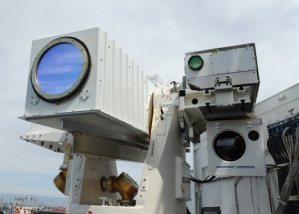 The Navy has begun field testing early versions of its high-energy laser (HEL). In a press release, the U.S. military branch said that it successfully disabled a “small target vessel” on April 6, 2011. While the laser is still operating at a fraction of its final power, you can see it set fire to a boat engine in the video below.
The Navy has begun field testing early versions of its high-energy laser (HEL). In a press release, the U.S. military branch said that it successfully disabled a “small target vessel” on April 6, 2011. While the laser is still operating at a fraction of its final power, you can see it set fire to a boat engine in the video below.
Navy officials are calling the test a significant milestone toward a future where all Naval ships come equipped with ray guns. “This is the first time a HEL, at these power levels, has been put on a Navy ship, powered from that ship and used to defeat a target at-range in a maritime environment,” said Peter Morrison, ONR MLD program officer. “We are learning a ton from this program—how to integrate and work with directed energy weapons. All test results are extremely valuable regardless of the outcome.”
The current laser only uses 15 kilowatts of power, while the final versions will be 100+ kilowatt in power, meaning that though this current laser takes about as much time as it takes a kid with a magnifying glass to fry a bug, future versions will be much deadlier. Still, it is impressive that the 15 kilowatt system was able to target a vessel on the moving ocean in highly humid conditions.
However, with each new superweapon comes an equally strange and cool counter-attack. While lasers will soon guard our ships against almost everything, hypersonic railguns fire so fast that it’s unlikely that a targeting computer will be able to track and destroy them in a pinch. Luckily, the Navy is working on its own railguns too.


